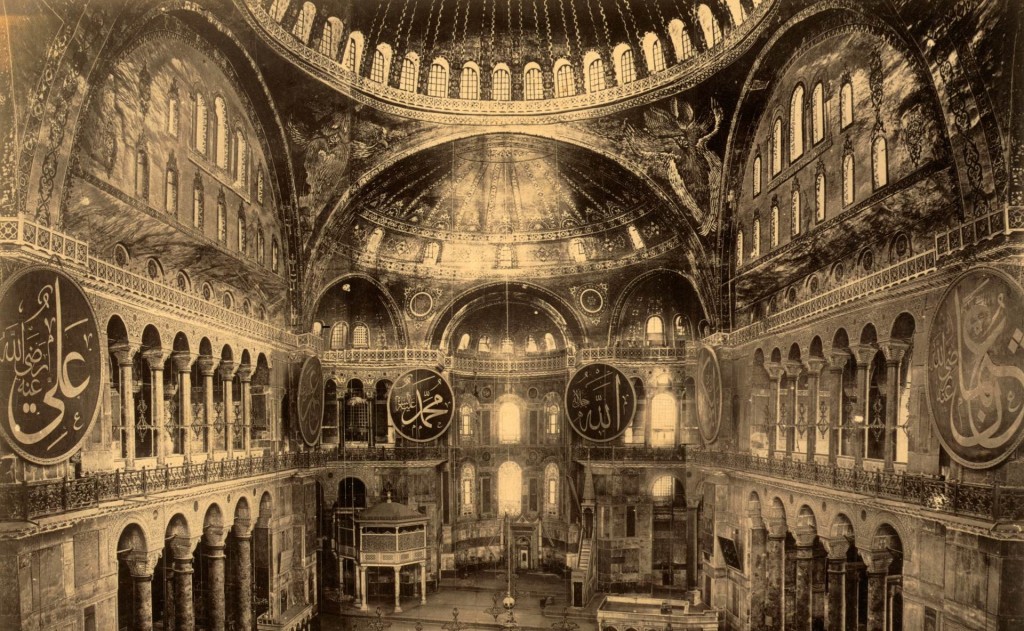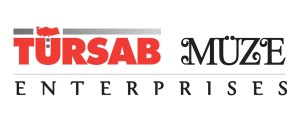Not only a historical landmark, but a genuine legend…
The Hagia Sophia (Turkish: Ayasofya), admired by kings and sultans for 1500 years, nowadays continues to welcome presidents and prime ministers. This splendid monument beyond compare has now returned to its period of youth, thanks to a relentless restoration effort.
The director of the museum, associate Prof. Dr. A. Haluk Dursun tells us about this labour of love, which continued for 17 years.
Rumour has it that EmperorJustinianus has rejoiced at the completion of the Hagia Sophia by exclaiming:
“I prevailed over you Solomon!” Meant was the fabulous Temple of Solomon, destroyed 586 B.C. by the Babylonians… Not a single artifact was found which could be related to the Temple with certainty during the various excavations conducted at its supposed emplacement at Mount Temple in Jerusalem. Nevertheless, Solomon’s Temple remained a powerful legend up until our days.
Justinianus realized his own dream by having the great Hagia Sophia erected as a challenge to that legend.
Then, the Hagia Sophia remained as the unique sovereign at the pinnacle of architectural achievements until Ottoman Architect Sinan built the Süleymaniye Mosque.
The Hagia Sophia, built between 532 and 537 A.D, is an incomparable monument for all followers of the Byzantine heritage and for the world’s cultural history.
Translated into the English language Hagia Sophia means “holy wisdom”. The basilica was a point of attraction for all civilizations of its era. Kings, emperors, sultans, they were all dreaming of entering through the porch of Hagia Sophia as victorious sovereign following their conquest of Constantinople.
Eventually, it was the fate of Fatih Sultan Mehmet, Sultan Mehmet II the Conqueror, to turn this dream into reality. He con quered the city in 1453, putting an end to the Eastern Roman Empire and the Hagia Sophia was transformed into the Ayasofya Mosque, as landmark of this great victory.
The legendary monument is nowadays a museum witnessing to its glorious past. The restoration work which lasted 17 years came finally to an end.
The scaffolding disturbing the view inside the building is gone, the original mosaics were cleaned and repaired. An angel face on one of the domes overlaid with stucco for many years has been uncovered. The sultans’ tombs in the courtyard were opened to the public, the renovated baptistery and the recently unearthed “baptismal font” provoked great interest in international art circles. The Children’s School situated in the courtyard of Hagia Sophia was revitalized after centuries.
The Director of the Museum Haluk Dursun and his young and dynamic team are the ones who put their signature under all these efforts. Haluk Dursun, who initiated a new era at the Ayasofya, one of the pinnacles of world cultural heritage, answered our questions.
MÜZE DERGİ: What is the daily average number of visitors at the Hagia Sophia Museum? Which days of the week are the busiest?
HALUK DURSUN: The busiest day is Tuesday, because of the fact that the Topkapı Palace Museum is closed on those weekdays. Thus, all tourists visiting İstanbul are rushing to the Hagia Sophia on Tuesdays. A minimum of 10 thousand foreign guests are coming to our museum every Tuesday. On week-ends, we rather welcome domestic tourists. There are even days where the number of visitors is exceeding 15 thousand. The museum personnel are used to taking on great crowds.
MÜZE DERGİ: The Hagia Sophia takes certainly place on the itinerary of foreign dignitaries on State or official visits to Turkey. Who were these VIP’s in recent years?
HALUK DURSUN: There is practically no foreign statesman leaving İstanbul without having been to the Hagia Sophia. This building is a landmark guarding marks from both the Eastern Roman and Ottoman Empires. The protocol visits last approximately 20 to 40 minutes, during which we seek to communicate a cultural message. Following the visits of Pope Benedict XVI and President Barack Obama, the idea of the Hagia Sophia being the standard protocol museum has established itself. Prince Charles, the spouse of Syrian President Bashar Assad, Ms. Asma Assad are among those dignitaries who devote a special interest to our museum.
They occasionally effectuate private visits here and it is my duty and honour to present to them during such visits, in-depth information on their area of special interest. The subjects vary from mysticism to architecture or the genuine “culture of death” which is embodied in this sanctuary.
MÜZE DERGİ: Would you please dwell upon the significant changes which occurred during your tenure here as Director?
HALUK DURSUN: The office and restroom structures in the courtyard were obstructing the way and the view to the sultans’ tombs, built by the great Ottoman Architect Sinan.
I attributed great importance to having these unfitting dwellings removed and re-built in an adequate fashion at a more appropriate ocation, we even added a baby changing room to it. We are grateful to TÜRSAB for their assistance in this matter.
Secondly, we completed the restoration of the dome. The entire dome has been lead sealed and humidity measures were taken. The tesserae, the mosaics covering a total area of 19 thousand square metres were cleaned and solidified through special millimetric injections. Thanks to the completion of the restoration work begun 17 years ago, we were finally able to remove those scaffoldings spoiling the inside appearance of the Hagia Sophia.
MÜZE DERGİ: You received an award concerning a specific mosaic which was unveiled during the restorations. What is the particular significance of that mosaic?
HALUK DURSUN: Indeed, we unveiled a genuinely important mosaic during the restoration of the dome. The Swiss-Italian architect brothers Gaspare and Guiseppe Fossati who carried out some restoration work at the Hagia Sophia during the reign of Sultan Abdülmecid had covered the face of the “Seraphim Angel” mosaic featuring a six winged cherub figure. This mosaic was recently cleaned to reveal the face of the angel Seraphim which had been covered for about 160 years.
The Hagia Sophia was chosen as European Museum of the Year for 2010 thanks to the comprehensive restoration work. Furthermore, I was presented with Italy’s prestigious “Rotondi Award” (Premio Rotondi 2010 ai Salvatori dell’Arte) in a ceremony held in Sassocorvaro city in central Italy on September 25, 2010. A special section is now consecrated to the Hagia Sophia at the Rotondi Centre for the Saviours of Art.
The “Rotondi Award” is presented to individuals or institutions making contributions to cultural heritage every year since 1996.
MÜZE DERGİ: Which sections of the museum were opened to the public which could not be visited before?
HALUK DURSUN: It became urgent to make new areas available to the public, to assure a smooth flow of visitor crowds peaking at 15 thousand people at times.
We opened the “Sultans’ Tombs Department” where the tombs of Sultan Selim II, Sultan Murat III and Sultan Mehmet III are located. These tombs were designed by Architect Sinan and other eminent architects of the 15th and 16th centuries.
They are decorated inside with calligraphies, ceramics, mother of-pearl, and metal engravings. This department can be visited free of charge.
The baptistery was restored to its original state. Hagia Sophia’s Byzantine baptistery building had been turned into an Ottoman sultans’ tomb, and the sixth-century baptismal font in it was moved to the baptistery’s courtyard. The sultans who were buried in the tomb were those who had been dethroned.
When Sultan Mustafa I and Sultan Ibrahim were buried there, the baptistery turned into a sultans’ tomb and the baptismal font in it was moved to the court without being damaged. It remained under the soil. This court is a very beautiful section showing Byzantine art.
Olive oil was used in baptism ceremonies in Byzantine Orthodox culture. Historical olive oil cubes and sarcophaguses were also unearthed in the court. As part of the restoration work in 2010, the baptistery’s courtyard was restored and the baptismal font was unearthed.
This font was used in mass baptism ceremonies. The baptismal font is 3.32 meters long, 2.52 meters wide and 1.16 meters deep. It is the world’s oldies and largest baptismal font. Its discovery aroused great interest in international art circles.
MÜZE DERGİ: Greater emphasis was placed on the Islamic period of the building through the opening to the public of the Sultans’ Tombs. Did this contribute to a shift in the museum’s image or to a diversification of the visitors’ profile?
HALUK DURSUN: World’s largest Greek-Orthodox baptismal font as well as the largest Moslem ritual ablutions’ fountain built by the Ottomans are both here. One can admire here the imperial mosaics as well as the “Çinili Türbe”- the Tiled Tomb, a master piece by the greatest Ottoman Architect Sinan.
Yes, the Hagia Sophia was originally built as a Byzantine basilica, but very valuable Islamic cultural elements were added to its decoration over the centuries, some giant calligraphies personally manufactured by sultans, priceless mother-of-pearl inlays, hand-drawn decorations etc. Indeed, the emphasis on the Islamic aspects of our museum paved the way to an increase in the number of devout Moslem visitors, hose elderly people who take a rest in our roses, hyacinth and lilac gardens after their visit at the museum.
This article has originally appeared in “Müze” Magazine, published quarterly with the contributions of the Ministry of Culture and Tourism. We would like to thank TÜRSAB Museum Enterprises for sharing this piece with Istanbul Digital Platform followers.




















